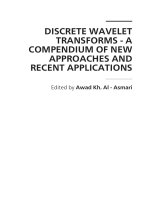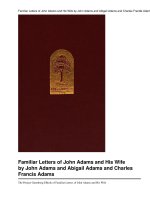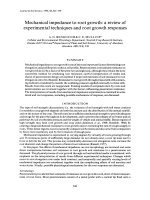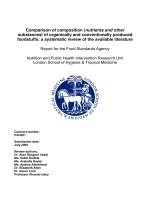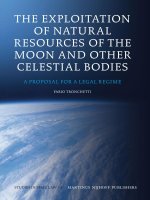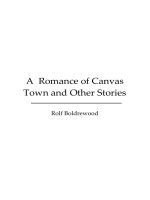- Trang chủ >>
- Khoa Học Tự Nhiên >>
- Vật lý
a memoir of jane austen and other family recollections dec 2002
Bạn đang xem bản rút gọn của tài liệu. Xem và tải ngay bản đầy đủ của tài liệu tại đây (2.71 MB, 352 trang )
’
A MEMOIR OF JANE AUSTEN
J E A-L (–), the only son of Jane
Austen’s eldest brother James and his second wife Mary Lloyd, was born
at Deane parsonage, Hampshire, and moved the short distance to Steven-
ton rectory in , aged , when his father became rector there on his
grandfather’s retirement to Bath. Thus he spent his childhood and youth
in the same house in which Jane Austen had spent hers. After school at
Winchester he went to Exeter College, Oxford, was ordained in ,
and, like his father and grandfather, became a country clergyman. As a
schoolboy he wrote verses and even began a novel, which Jane Austen
encouraged. He represented his father at her funeral in . Upon his
great-aunt Jane Leigh Perrot’s death in he inherited the estate of
Scarlets, taking the name of ‘Leigh’ in addition to Austen. In he
became vicar of Bray, near Maidenhead, where he lived until his death. A
keen huntsman, it was his late success as a published writer with Recollec-
tions of the Vine Hunt () which encouraged him to begin the Memoir
in the Spring of , in which he drew upon the memoirs of his sisters
Anna Lefroy and Caroline Austen, and of his uncle Henry Austen.
K S is Professorial Fellow in English at St Anne’s
College, Oxford. She has published widely on fictional and non-fictional
writings of the Scottish Enlightenment and Romantic periods. Her edi-
tions include Jane Austen’s Mansfield Park (for Penguin Classics). She is
currently completing a critical study of Austen under the title Jane
Austen’s Textual Lives.
’
For over years Oxford World’s Classics have brought
readers closer to the world’s great literature. Now with over
titles–– from the ,-year-old myths of Mesopotamia to the
twentieth century’s greatest novels–– the series makes available
lesser-known as well as celebrated writing.
The pocket-sized hardbacks of the early years contained
introductions by Virginia Woolf, T. S. Eliot, Graham Greene,
and other literary figures which enriched the experience of reading.
Today the series is recognized for its fine scholarship and
reliability in texts that span world literature, drama and poetry,
religion, philosophy and politics. Each edition includes perceptive
commentary and essential background information to meet the
changing needs of readers.
OXFORD WORLD’S CLASSICS
J. E. AUSTEN-LEIGH
A Memoir of Jane Austen
and Other Family Recollections
Edited with an Introduction and Notes by
KATHRYN SUTHERLAND
1
3
Great Clarendon Street, Oxford
Oxford University Press is a department of the University of Oxford.
It furthers the University’s objective of excellence in research, scholarship,
and education by publishing worldwide in
Oxford New York
Auckland Bangkok Buenos Aires Cape Town Chennai
Dar es Salaam Delhi Hong Kong Istanbul Karachi Kolkata
Kuala Lumpur Madrid Melbourne Mexico City Mumbai Nairobi
São Paulo Shanghai Singapore Taipei Tokyo Toronto
Oxford is a registered trade mark of Oxford University Press
in the UK and in certain other countries
Published in the United States
by Oxford University Press Inc., New York
Editorial matter © Kathryn Sutherland 2002
See Acknowledgements for further copyright details
The moral rights of the author have been asserted
Database right Oxford University Press (maker)
First published as an Oxford World’s Classics paperback 2002
All rights reserved. No part of this publication may be reproduced,
stored in a retrieval system, or transmitted, in any form or by any means,
without the prior permission in writing of Oxford University Press,
or as expressly permitted by law, or under terms agreed with the appropriate
reprographics rights organization. Enquiries concerning reproduction
outside the scope of the above should be sent to the Rights Department,
Oxford University Press, at the address above
You must not circulate this book in any other binding or cover
and you must impose this same condition on any acquirer
British Library Cataloguing in Publication Data
Data available
Library of Congress Cataloging in Publication Data
Data available
ISBN 0–19–284074–6
13579108642
Typeset in Ehrhardt
by RefineCatch Limited, Bungay, Suffolk
Printed in Great Britain by
Clays Ltd, St Ives plc
ACKNOWLEDGEMENTS
In preparing this edition I have incurred many debts and received
advice and assistance from several sources. My greatest debt is to
Deirdre Le Faye, who generously shared with me her Jane Austen
scholarship and knowledge of the archives; she also checked my
text of Caroline Austen’s My Aunt Jane Austen: A Memoir against
the manuscript in Jane Austen’s House, Chawton. I am grateful
to the staff of the Hampshire Record Office, Winchester; to the
staff of the Heinz Archive, the National Portrait Gallery; to
Judith Priestman of the Modern Manuscripts Room, Bodleian
Library; and to the staff of Balliol College and St Anne’s College
Libraries, Oxford. My thanks for specific and general advice go to
Geneviève Baudon Adams, Claire Harman, Tom Keymer, Claire
Lamont, Hermione Lee, Matthew Leigh, and Jim McLaverty; to
my sister Moira Wardhaugh for helping me think about family
memories; and to Judith Luna for her enthusiasm for the project.
I am grateful to the Archive Department of the Hampshire
Record Office and to the Heinz Archive and Library, the National
Portrait Gallery, for permission to publish manuscript materials
in their possession. I would also like to thank Brian Southam
and the Jane Austen Society for permission to reprint Caroline
Austen’s My Aunt Jane Austen: A Memoir. For permission to
reproduce images of family members, my thanks go to Katharine
Beaumont, T. F. Carpenter of the Jane Austen Memorial Trust,
and to Maggie Lane.
This page intentionally left blank
CONTENTS
List of Illustrations ix
The Austen Family Tree x–xi
Introduction xiii
Note on the Texts xlix
Select Bibliography lii
A Chronology of the Austen family lviii
. . -
A Memoir of Jane Austen ()
‘Biographical Notice of the Author’ ()
‘Memoir of Miss Austen’ ()
‘Recollections of Aunt Jane’ ()
My Aunt Jane Austen: A Memoir ()
Appendix: Family Letters
Explanatory Notes
Index
This page intentionally left blank
LIST OF ILLUSTRATIONS
James Edward Austen-Leigh, a portrait added as a
frontispiece to the Memoir, ed. R. W. Chapman () lxiv
Jane Austen, steel-engraved portrait by Lizars from a
likeness drawn by Mr Andrews of Maidenhead (after
Cassandra Austen’s watercolour sketch now in the
National Portrait Gallery, London), used as a frontispiece
to the first edition of the Memoir ()
Wood engraving of Steventon Parsonage
Wood engraving of Steventon Manor House
Wood engraving of Chawton Church
Lithographic facsimile of an autograph manuscript of
the verses on Mr Gell and Miss Gill, now in the Pump
Room, Bath
Henry Austen, miniature, c.
Private collection
Anna Lefroy as a young woman
Jane Austen Memorial Trust
Anna Lefroy in later life,
Maggie Lane
Caroline Austen as a child
Private collection
Caroline Austen as an old lady
Private collection
INTRODUCTION
The Business of Biography
When in Robert Chapman published his edition of James
Edward Austen-Leigh’s biography of his aunt Jane Austen the
Times Literary Supplement chiefly welcomed its reissue not for
the life it recorded but for the manuscripts described in it.
Under the heading ‘Manuscripts of Jane Austen’, it concen-
trated on that feature of the Memoir which ‘makes it necessary
to the complete Austenian . . . the particular account, in Mr
Chapman’s introduction, of the manuscripts of Jane Austen’s
letters and of her other writings’. The reviewer continued:
‘Here we may find . . . the last word about Jane Austen manu-
scripts, which not only is a thing to welcome for its own sake
but may help to bring to light other manuscripts which are
known to exist, or to have existed, but have been lost to sight’.
1
In the manuscript notebook of juvenilia, Volume the First,
was known outside Austen family circles only by the two scenes
of the spoof play ‘The Mystery’, printed by Austen-Leigh in
and perhaps written as early as (when Jane Austen
was or ). After and Austen-Leigh’s second edition of
the Memoir, enlarged with early or unfinished manuscript drafts
of several ‘new’ Jane Austen works (the cancelled chapter of
Persuasion, Lady Susan, The Watsons, and a synopsis of Sandi-
ton), there was no further printing of such material until the
s; readers had to wait until for the first publication of
Volume the Third, the last of the juvenile manuscript books.
There was an important exception to this silence, in the edition
in of Jane Austen’s Letters by her great-nephew Lord Bra-
bourne, which brought to public light eighty-four autograph
letters in the possession of Lord Brabourne’s mother, Jane
Austen’s niece, Fanny Knight (Lady Knatchbull), and a minor
1
Times Literary Supplement, Mar. , p. .
exception in the printing in of Charades . . . by Jane Austen
and her Family.
But in the s Chapman was busy distinguishing life from
works and extending the Jane Austen canon beyond the six major
novels on which her reputation so far rested. He had published or
was planning separate and handsomely produced editions of the
non-canonical writings that Austen-Leigh had chosen, after fam-
ily consultation, to stretch out his biography, and it did not seem
impossible that more manuscripts might come to light, especially
as materials in family ownership were now beginning to appear in
the auction rooms. Chapman was particularly concerned at this
time with tracing Volume the First and the whereabouts of surviv-
ing Jane Austen letters. This explains his slant on the Memoir in
his brief introduction: its importance to him is as a frame on
which to hang the extant literary remains and as a guide to the
reconstruction of writings which may or may not still exist. Even
now this aspect of Austen-Leigh’s work cannot be disregarded;
in some cases the Memoir provides the only documentary
authority–– for certain letters and for the mock panegyric to Anna
Austen (‘In measured verse I’ll now rehearse’).
2
But more subtly
at work on Chapman’s own Austenian ambitions in was the
influence of later generations of the family as biographers and
keepers of the archive. In James Edward’s grandson Richard
Arthur Austen-Leigh had published with his uncle William
Austen-Leigh an expanded biography, Jane Austen: Her Life and
Letters. A Family Record, enlarging the account with
materials drawn from other branches of the family. Substantially
updated and largely rewritten by Deirdre Le Faye in , A
Family Record remains the ‘authorized’ reference or ‘factual’
biography. The absence of biographical notice or speculation
from Chapman’s introduction and appended notes to his edition
of the earlier Austen-Leigh memoir not only registers a reticence
to engage critically with what in was still family business, it
was also the prudent act of a scholar and publisher eager to claim
2
e.g. those letters printed as nos. , , and , in Jane Austen’s Letters, ed.
Deirdre Le Faye (rd edn., Oxford: Oxford University Press, ). For the verses to
Anna Austen, see p. of the Memoir and note.
Introductionxiv
the literary remains in family hands for his own shaping. Chap-
man was Secretary to the Delegates at Oxford University Press,
which had as recently as issued under its Clarendon imprint
his pioneering edition of the six novels–– not only the first accur-
ate text of Jane Austen’s novels, after the careless reprint history
of the nineteenth century, but the first major textual investigation
of the English novel as a genre.
Since there has been no serious editorial engagement
with the Memoir and little critical attention paid to it.
3
Yet James
Austen-Leigh here assembled a major work of Austenian biog-
raphy which stands unchallenged as the ‘prime source of all
subsequent biographical writings’.
4
This is even clearer when, as
in Chapman’s edition and in the edition printed here, the Mem-
oir is cut free from the manuscript writings which in
threatened to overshadow it. What is left is an account of a life
shaped and limited by the recollections, affections, and preju-
dices of a very few family members who knew her. But it is
worth dwelling on those drafts a little longer because, by attach-
ing Lady Susan and The Watsons to the Memoir text of ,
James Austen-Leigh, by this time an elderly and respectable
Victorian clergyman, may be said to have undermined his overt
purpose. ‘St. Aunt Jane of Steventon-cum-Chawton Canonico-
rum’, as Austen-Leigh’s hagiographic portrait has been wittily
dubbed, is a comfortable figure, shunning fame and professional
status, centred in home, writing only in the intervals permitted
from the more important domestic duties of a devoted daughter,
sister, and aunt. ‘Her life’, her nephew summarized, ‘had been
passed in the performance of home duties, and the cultivation of
domestic affections, without any self-seeking or craving after
applause’ (p. ). To such a meek spirit, writing was of no more
value than needlework, at which she equally excelled: ‘the same
hand which painted so exquisitely with the pen could work as
delicately with the needle’ (p. ). Indeed, when Austen-Leigh
3
An exception must be made for D. W. Harding’s edition, issued as an appendix to
Persuasion (Harmondsworth: Penguin Books, ).
4
As stated by David Gilson in his introduction to the facsimile reprint of the ,
first edition of the Memoir (London: Routledge/Thoemmes Press, ), p. xiii.
Introduction xv
describes her writing it is her penmanship and the look of the
page that concerns him, as it concerns her brother Henry (‘Every
thing came finished from her pen’) and niece Caroline, who
records somewhat curiously that ‘Her handwriting remains to
bear testimony to its own excellence’ (p. ). But the unpub-
lished manuscripts speak a different story –– of long apprentice-
ship, experiment and abandonment, rewriting and cancellation,
and even of a restless and sardonic spirit. They provide unassail-
able evidence to upset some of Austen-Leigh’s chief state-
ments about Jane Austen the author; considered by the light
of these irreverent works her steady moral sense looks more
ambiguous, her photographic naturalism (‘These writings are
like photographs . . . all is the unadorned reflection of the natural
object’ (p. ) ) less trustworthy. The unpublished writings
challenge Austen-Leigh’s image of the writer who is first and
foremost ‘dear Aunt Jane’, whose novels are the effortless
extensions of a wholesome and blameless life lived in simple
surroundings:
[Steventon] was the cradle of her genius. These were the first objects
which inspired her young heart with a sense of the beauties of nature.
In strolls along those wood-walks, thick-coming fancies rose in her
mind, and gradually assumed the forms in which they came forth to
the world. In that simple church she brought them all into subjection
to the piety which ruled her in life, and supported her in death.
(pp. –)
On the contrary, the manuscript pieces, both early and late, show
a rawer, edgier, social talent (of the major Romantic-period
writers she is the least ‘natural’), and reveal that the artlessness of
the finished works is the result of laboured revision, of painful
inner struggle, rather than unconscious perfection. Bound
together, they irresistibly implied a new Austen novel; once read,
they even suggested a new Jane Austen. Chapman reminds us
that, ‘by inadvertence or cunning’, the publisher Richard Bentley
had the spine of the second edition of the Memoir printed to read
Lady Susan &c; and this is how it was subsequently issued in the
six-volume Steventon set of Jane Austen’s Novels (), where
Introductionxvi
volume is Lady Susan, The Watsons, &c. (With a Memoir and
Portrait of the Authoress).
5
Since the emphasis has shifted –– the manuscript writings
have been absorbed into the canon, changing our readings of the
six novels and, more pertinently here, literary biographers have
appropriated the ‘family record’, discovering or imposing psycho-
logical and aesthetic forms to explain and expand the little we
know of Jane Austen’s life. But a better way to describe literary
biography, caught somewhere between the ‘facts’ of historical
documentation and the competing ‘truth’ of imaginative associ-
ation, might be to say that biography is not so much an attempt to
explain as an attempt to satisfy. In a now notorious review of
Deirdre Le Faye’s revised edition of the Letters, Terry Castle
wrote that the reader of Jane Austen’s fiction is ‘hungry for a
sense of the author’s inner life’.
6
If this is so–– and the number of
Austen biographies even since the revised Letters of argues
that our appetites remain keen–– then it is not facts or explan-
ations we crave but intimacy and identification. Writers them-
selves have regularly expressed distaste or fear at the hunger for
biographical detail which their own creativity has fuelled and
which threatens to invade every private corner. George Eliot
viewed biography as a ‘disease’, complaining to her publisher
John Blackwood of the posthumous fascination with the details of
Dickens’s life: ‘Is it not odious that as soon as a man is dead his
desk is raked, and every insignificant memorandum which he
never meant for the public, is printed for the gossiping amuse-
ment of people too idle to re-read his books?’
7
But, as theorizers
of biography regularly note, it is the novel itself–– more
particularly, the nineteenth-century realist novel, with its illusion
of the comprehensive and comprehensible life–– which is the
biographer’s readiest model. It is not that we are too idle to reread
5
Memoir, ed. R. W. Chapman (Oxford: Clarendon Press, ), p. viii. The advertise-
ment for the Steventon Edition of the novels, printed in the second volume of Letters of
Jane Austen, ed. Edward, Lord Brabourne ( vols., London: Richard Bentley and Son,
), attaches the notice of the Memoir in brackets after Lady Susan, The Watsons, &c.
6
Terry Castle, ‘Sister-Sister’, London Review of Books, Aug. , p. .
7
The George Eliot Letters, ed. Gordon S. Haight ( vols., New Haven: Yale
University Press, –), vi. , Eliot to Blackwood, Feb..
Introduction xvii
works of literature, but rather that one powerful consequence of
reading certain kinds of literature (and especially novels) is our
wish to extend and bring closer to us the illusion of knowing and
of knowingness they create. The novel-writer is by association the
inevitable victim of the hunger her imagination has stimulated
and appeared to appease. And, as John Wiltshire suggests, ‘of all
writers in the canon, Jane Austen is the one around whom this
fantasy of access, this dream of possession, weaves its most
powerful spell’.
8
Because she is more than usually retiring,
because there seems so little to know, because her plotless fictions,
themselves the subtlest and most tactful of biographies, present
human beings in the fascinating light of their trivial and essential
moments, we long to know more. Her novels absorb us deeply
and, in a genre where absorption is a conventional expectation,
even uniquely. We cannot believe that they will not lead us back to
their author. Against this natural longing, artfully stimulated, we
should set that other, more sceptical knowledge which novels try
to teach us: ‘Seldom, very seldom, does complete truth belong to
any human disclosure; seldom can it happen that something is not
a little disguised, or a little mistaken’, the narrator of Emma
warns the naïve reader; while, for the narrator of Flaubert’s
Parrot, biography is ‘a collection of holes tied together with
string’.
9
But biography, like novels, is built on paradoxes.
If we look in James Austen-Leigh’s memoir for the kinds of
encounter with the individual life that we have come to expect
from literary biographies of the twentieth century we will be
disappointed. While his account remains the printed authority
for so much of what we know, it is marked by a lack of candour
that frustrates reinterpretation. There are several reasons for this,
but all can be summed up by the family constraints on its con-
struction. The details of the life of no other famous individual are
so exclusively determined through family as are those of Jane
Austen. Not only is it the case that surviving letters, manuscripts,
8
John Wiltshire, Recreating Jane Austen (Cambridge: Cambridge University Press,
), .
9
Emma, vol. , ch. ; and Julian Barnes, Flaubert’s Parrot (London: Jonathan Cape,
), .
Introductionxviii
and other material witnesses remained largely in family hands for
a hundred years after her death, but there is no non-fictional
evidence for a ‘self ’ other than that constructed within the
bounds of family. No diaries or personal writings have come
down to suggest the existence of an inner life, a self apart. If there
is no autobiographical record, there is also very little by way of a
non-familial social or public record. The archive of her later pub-
lisher John Murray has yielded nothing but the barest details of a
professional relationship conducted with respect and good will
on both sides–– no hints of literary parties at which Miss Austen
might have been a guest. Henry Austen, in his second,
‘Memoir’, can only mention as noteworthy the meeting with
Germaine de Staël which did not take place, while the introduc-
tion to the Prince Regent’s librarian, James Stanier Clarke,
becomes significant chiefly as it is transformed into the comic
‘Plan of a Novel’. What are left are family memories, which if not
totally consensual in the ‘facts’ they collectively register, are suf-
ficiently convergent and mutually endorsing to determine the
biographical space as only familial. The modern biographer, for
whom the interest of a life generally increases in proportion to its
inwardness, is defeated by this absence of a resistant private voice.
The comparison that Austen-Leigh invites us to make is with
Charlotte Brontë, and it is more interesting than at first appears.
Elizabeth Gaskell’s Life of her friend and fellow-novelist had
been published as recently as , setting a standard for the
simultaneous memorializing and effacing of its difficult subject,
the female writer, that proved influential on Austen-Leigh. In
Chapter he compares his aunt’s seclusion from the literary
world with the details Gaskell revealed of Brontë’s shunning of
public applause. That the Jane Austen we encounter in Austen-
Leigh’s account is as inadequate to the novels we now read as is
Gaskell’s Brontë can be explained in each case by the Victorian
biographer’s project of domestication. But there is an added twist
whereby the novelist whom Brontë found too ‘confined’, and
from whose ‘mild eyes’ shone the unwelcome advice ‘to finish
more, and be more subdued’, becomes liable to a biographical
constraint which in some part derives from Gaskell’s earlier
Introduction xix
authoritative presentation of Brontë as herself the respectable
and unpushy lady novelist. Austen-Leigh quotes (at p. ), via
Gaskell, Charlotte Brontë’s now famous denunciation of Jane
Austen’s quiet art; but Gaskell’s elevation of the ideal domestic
woman, modest spinster daughter of a country parson, one not
‘easily susceptible’ to ‘the passion of love’ in which her novels
abound,
10
is clearly instructive for his later presentation of an
equally saintly heroine whose emotional and intellectual life never
ranged beyond the family circle, and whose brushes with sexual
love were so slight as to warrant hardly a mention. Where
Gaskell’s Brontë walks ‘shy and trembling’ (p. ) through the
London literary scene, Austen-Leigh’s Aunt Jane refuses any and
every public notice with an energetic determination that trans-
forms rural Hampshire into a farther retreat than Siberia, let
alone Gaskell’s exaggeratedly remote Yorkshire parsonage. Jane
Austen lived (we are told), with unnecessarily shrill emphasis, ‘in
entire seclusion from the literary world: neither by correspond-
ence, nor by personal intercourse was she known to any con-
temporary authors’ (p. ). Austen-Leigh’s biography presents
what it cannot (or will not) know about creative genius in terms of
a withdrawal of imaginative speculation, a deflection of enquiry
into anything as intense, familially disruptive, or counter-social as
writing. When he equates Jane Austen’s literary creativity with
her other forms of manual dexterity–– her use of sealing wax, her
games with cup and ball and spilikins–– he conceals within
domestic pastime what must also have been a profoundly
undomesticated, self-absorbed activity. Beyond a certain point
the familial perspective is irrelevant, even dishonest.
Origins
The decision to prepare a biography of Jane Austen was taken by
the family in the late s. Admiral Sir Francis Austen, her last
10
Mrs Gaskell, The Life of Charlotte Brontë, ed. Alan Shelston (Harmondsworth:
Penguin Books, ), . For a recent, metabiographical examination of the treatment
of Charlotte and Emily Brontë by their biographers, see Lucasta Miller, The Brontë
Myth (London: Jonathan Cape, ).
Introductionxx
surviving sibling, had died in August , aged . His death
marked the end of her generation and therefore a moment for
gathering the family record in written form. In addition, those
nieces and nephews who had known her in their childhoods were
also now old and wished to hand on, within the family, some
account of their distinguished relative. ‘The generation who
knew her is passing away–– but those who are succeeding us must
feel an interest in the personal character of their Great Aunt, who
has made the family name in some small degree, illustrious’
(p. ), wrote Caroline Austen in her essay, subsequently
published as My Aunt Jane Austen. Significantly too, at about this
time, the public interest in Jane Austen’s novels, mounting grad-
ually since the s, showed signs of developing in at least two
ways that provided cause for concern. One was the anxiety that a
non-family-derived biography might be attempted; and the other
was the equal risk that another branch of the family might pub-
lish something injudicious. As the only son of the eldest branch,
James Edward Austen-Leigh assumed the task as a duty and in a
spirit of censorship as well as communication. Before him, the
public biographical account necessarily derived from Henry
Austen’s ‘Notice’ of or its revision as the ‘Memoir’
(both printed here), where even Henry, purportedly Jane
Austen’s favourite brother, eked out his brief evaluation with
lengthy quotation from the views of professional critics. Accord-
ing to Brian Southam’s estimate, there were only six essays
devoted exclusively to Jane Austen before ; but from the
s Lord Macaulay, George Henry Lewes, and Julia Kavanagh
were publicly attesting to her importance. In private, in his jour-
nal in , Macaulay noted his wish to write a short life of ‘that
wonderful woman’ in order to raise funds for a monument to her
in Winchester Cathedral.
11
The correspondence, in ,
between Frank Austen and the eager American autograph hunter
11
Jane Austen: The Critical Heritage, vol. , –, ed. B. C. Southam (Lon-
don: Routledge and Kegan Paul, ), . Southam prints extracts from the pioneer-
ing, pre- appraisals by Kavanagh, Lewes, and Macaulay in Jane Austen: The Critical
Heritage, vol. , – (London: Routledge and Kegan Paul, ). See, too, The Life
and Letters of Lord Macaulay, ed. George Otto Trevelyan ( vols., London: Longmans,
Green, and Co., ), ii. .
Introduction xxi
Eliza Susan Quincy, referred to by Austen-Leigh in the Memoir,
suggests a ready circle of devotees as far away as Boston,
Massachusetts.
James Edward Austen-Leigh was supported in his decision to
write the official family life of Jane Austen by his two sisters and
several of his cousins. As early as his elder, half-sister Anna
(Jane Anna Elizabeth Austen) Lefroy (–) was writing
down her memories in response to his enquiries (‘You have asked
me to put on paper my recollections of Aunt Jane, & to do so
would be both on your account & her’s a labour of love’ (see
p. ) ). They are printed in this collection as ‘Recollections of
Aunt Jane’. His younger sister Caroline Mary Craven Austen
(–) provided her reminiscences, as noted above, in .
These, too, are included in this collection. As the children of
Jane’s eldest brother, Anna, James Edward, and Caroline had
inhabited her natal home of Steventon, after their father James
took over as rector there on the retirement to Bath of his father
George Austen. All three were closer to Jane’s Hampshire roots
(socially as well as geographically) than other branches of the
family, notably the grander Knights of Godmersham, Kent, the
descendants of her third brother Edward. Of the numerous
nephews and nieces (of her six brothers, Edward, Frank, and
Charles produced eleven, ten, and eight children respectively),
James’s children had unique personal knowledge of their aunt
and were of an age to remember her. Anna Lefroy had known her
aunt from earliest childhood when she was brought to live at
Steventon after the death of her mother, James Austen’s first wife
Anne Mathew. Caroline, though much younger and only when
her aunt died, stayed often at Jane Austen’s later home at Chaw-
ton, while James Edward (known as Edward in the family) was
the only one of his generation present at his aunt’s funeral. Of the
other nieces to have known their aunt, Cassandra Esten Austen
(–), Charles Austen’s eldest daughter, and Mary Jane
Austen (–), Frank’s eldest daughter, were both regular vis-
itors to Chawton in their childhood. Mary Jane was now dead,
but Cassy Esten was her aunt Cassandra Austen’s executrix for
her personal effects, and since her own father’s death had
Introductionxxii
inherited many papers belonging either to Jane or Cassandra. She
shared information, recollections, and copies of Aunt Jane’s let-
ters with her cousin James Edward. Another promising source of
memories and archival materials should have been Fanny Knight,
now Lady Knatchbull (–), Edward Austen Knight’s first
child who, just three months older than Anna, was Jane Austen’s
eldest niece. At the division of their aunt Cassandra’s papers after
her death in , Fanny had inherited the bulk of those letters
from Jane to her sister that Cassandra had chosen to preserve.
But by the s Fanny’s memory was confused, she was senile,
and other family members were unable or reluctant to trace the
whereabouts of the letters. His cousin, Fanny’s sister, Elizabeth
Rice (–), wrote to Austen-Leigh at this time: ‘it runs in her
head that there is something she ought to do till her brain gets
quite bewildered & giddiness comes on which of course is very
alarming–– I really do not think that it is worth your while to
defer writing the Memoir on the chance of getting the letters for
I see none.’
12
Lady Knatchbull’s daughter Louisa returned the
same reply to requests for letters, adding ‘I only wish the
“Memoirs” had been written ten years ago when it would have
given my Mother the greatest pleasure to assist, both with letters
and recollections of her own’.
13
The gap which these unforthcoming letters and recollections
suggest for our retrospective understanding of Austen-Leigh’s
account is worth considering. Fanny Knight has been represented
to posterity as the favourite niece, in Jane Austen’s own words
‘almost another Sister’ (to Cassandra, October ).
14
It was a
bond strengthened by the death of her mother when Fanny was
only . As Anna Lefroy, another motherless niece, records in her
‘Recollections of Aunt Jane’: ‘Owing to particular circumstances
there grew up during the latter years of Aunt Jane’s life a great &
affectionate intimacy between herself & the eldest of her nieces;
12
NPG, RWC/HH, fo. , National Portrait Gallery, London, a file of correspond-
ence between R. W. Chapman and Henry Hake, containing typescripts made from
‘letters addressed to James Edward Austen-Leigh about the date of the composition &
publication of the Memoir and preserved by him in an album’.
13
NPG, RWC/HH, fo. .
14
Jane Austen’s Letters, ed. Le Faye, .
Introduction xxiii
& I suppose there a [sic] few now living who can more fully
appreciate the talent or revere the memory of Aunt Jane than
Lady Knatchbull’ (see pp. –). But in the same place Anna
also writes that Fanny’s family, the Knights of Godmersham, felt
a general preference for Cassandra Austen and that they viewed
Jane’s talent with some suspicion–– intellectual pursuits and a
passion for scribbling did not fit with their finer family preten-
sions. Though Jane was welcome at Godmersham, she stayed
there less frequently than Cassandra, was less intimate in the
family circle, and expressed some unease with its ways. Time
undoubtedly dulled Fanny Knight’s earlier attachment to Aunt
Jane; so much so that Anna’s recollections quoted above assume a
wonderful inappropriateness when set against the record we do
have of Fanny’s opinion in . Senile or not, she had energy
enough to write down this memory for her sister Marianne when
she in turn raised Austen-Leigh’s enquiries:
Yes my love it is very true that Aunt Jane from various circumstances
was not so refined as she ought to have been from her talent & if she
had lived years later she would have been in many respects more
suitable to our more refined tastes. They were not rich & the people
around with whom they chiefly mixed, were not at all high bred, or in
short anything more than mediocre & they of course tho’ superior in
mental powers & cultivation were on the same level as far as refinement
goes–– but I think in later life their intercourse with Mrs. Knight (who
was very fond of & kind to them) improved them both & Aunt Jane
was too clever not to put aside all possible signs of ‘common-ness’ (if
such an expression is allowable) & teach herself to be more refined, at
least in intercourse with people in general. Both the Aunts (Cassandra
& Jane) were brought up in the most complete ignorance of the World
& its ways (I mean as to fashion &c) & if it had not been for Papa’s
marriage which brought them into Kent, & the kindness of Mrs.
Knight, who used often to have one or other of the sisters staying with
her, they would have been, tho’ not less clever & agreeable in them-
selves, very much below par as to good Society & its ways. If you hate
all this I beg yr. pardon but I felt it at my pen’s end & it chose to come
along & speak the truth.
15
15
Fanny Knight’s Diaries: Jane Austen through her Niece’s Eyes, ed. Deirdre Le
Faye (Alton: Jane Austen Society, ), –.
Introductionxxiv



